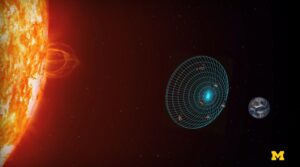NASA selects space science cubesat mission

WASHINGTON — NASA announced March 30 it will fund the development of a cluster of six cubesats that will fly in formation above geostationary orbit to study solar storms.
NASA said it selected for development the Sun Radio Interferometer Space Experiment (SunRISE) mission as a “mission of opportunity” for its heliophysics program. The mission, with a total cost of $62.6 million, will launch by July 2023.
SunRISE will consist of six cubesats, each six units in size, just above geostationary orbit. The six cubesats, flying in a formation about ten kilometers across, will form a virtual radio telescope to detect and pinpoint emissions from the sun associated with solar storms. Those radio waves can’t be detected on Earth because of interference from the Earth’s ionosphere.
Scientists believe such observations can help them better understand what solar activity can lead to major solar storms. “We can see a solar flare start, and a coronal mass ejection (CME) start lifting off from the sun, but we don’t know if it is going to produce high energy particle radiation, and we don’t know if that high energy particle radiation is going to reach Earth,” said Justin Kasper, principal investigator for SunRISE at the University of Michigan, in a university statement.
“It turns out the various theories about particle acceleration correspond to different parts of coronal mass ejections,” he continued. “So, if we can see which part of the CME is glowing in radio, we figure out which acceleration model is right.”
That can, in turn, help scientists identify those events that could produce high-energy particles that can result in hazardous space weather activity at Earth. “It could also result in a unique warning system for whether an event will both produce radiation and release that radiation towards Earth or spacefaring astronauts,” Kasper said.
NASA selected SunRISE as one of four mission of opportunity candidates in 2017. In February 2019, NASA selected another of those proposals, an International Space Station experiment called Atmospheric Waves Experiment (AWE), for development. However, the agency provided additional study money for SunRISE, concluding that while it was not yet ready to proceed into development then, “the proposed concept represents a compelling use of new NASA-developed technology.”
SunRISE will get to orbit flying on a commercial satellite built by Maxar. A system called the Payload Orbital Delivery System, attached to the satellite, will release the SunRISE cubesats once in orbit. Maxar spokesman Omar Mahmoud said March 30 that the company hasn’t identified the mission that will carry SunRISE, although the company said in a tweet it will be a satellite based on its 1300-series bus used for geostationary missions.
from SpaceNews.com https://ift.tt/2Us0n9Y
Comments
Post a Comment